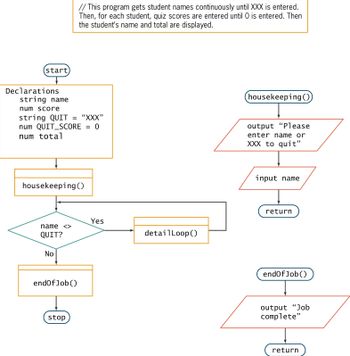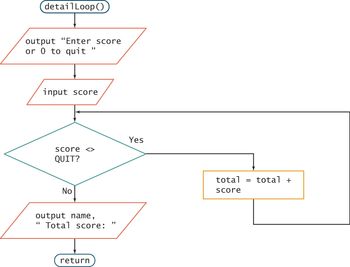
Computer Networking: A Top-Down Approach (7th Edition)
7th Edition
ISBN: 9780133594140
Author: James Kurose, Keith Ross
Publisher: PEARSON
expand_more
expand_more
format_list_bulleted
Question
Find the errors and circle them and explain why they need to be changed

Transcribed Image Text:The image illustrates a flowchart for a program designed to retrieve student names and quiz scores. The program continues to prompt for student names until "XXX" is entered to quit. For each student, quiz scores are entered until a score of 0 is specified. Finally, the cumulative score for each student is displayed.
### Flowchart Explanation:
1. **Start Node:**
- The process begins here.
2. **Declarations:**
- Variables are defined:
- `string name`
- `num score`
- `string QUIT = “XXX”`
- `num QUIT_SCORE = 0`
- `num total`
3. **Housekeeping Process:**
- Outputs the message: “Please enter name or XXX to quit.”
- Inputs a student's name into the variable `name`.
4. **Decision Node:**
- Checks whether `name` is not equal to `QUIT` (XXX).
- **Yes Path:** If true, continues to detail loop.
- **No Path:** If false, proceeds to end of job process.
5. **Detail Loop Process:**
- Actions that involve entering quiz scores and calculating totals would occur here.
6. **End of Job Process:**
- Outputs the message: “Job complete.”
- Ends the process.
7. **Stop Node:**
- The process terminates here.
This flowchart effectively outlines the logical sequence for entering and processing student names and scores, culminating in a display of results once all inputs have been processed or the quit condition is met.

Transcribed Image Text:The flowchart represents a function called `detailLoop()` used to process scores. Below is a detailed transcription and explanation of each step in the flowchart:
1. **Start**: The process begins with the `detailLoop()` function.
2. **Output Prompt**: The system outputs the prompt, “Enter score or 0 to quit”.
3. **Input Score**: The user inputs a score.
4. **Decision Point (QUIT?)**:
- Checks if the entered score equals 0.
- If Yes: The flow moves to the output section with the total score.
- If No: The process proceeds to update the total.
5. **Update Total**: The current score is added to the total using `total = total + score`.
6. **Loop Back**: After updating the total, the flow returns to the beginning, prompting the user to enter another score.
7. **Output Total Score**:
- When a score of 0 is entered, the output displays the name followed by “Total score: ” and the accumulated score.
8. **End**: The function returns and concludes the operation.
This flowchart illustrates a looping mechanism for continuously collecting scores and accumulating their total until the user decides to quit by inputting 0.
Expert Solution
This question has been solved!
Explore an expertly crafted, step-by-step solution for a thorough understanding of key concepts.
Step by stepSolved in 3 steps with 1 images

Knowledge Booster
Similar questions
- The Python code for step 7 is needed. Step 6 has been attached for data referencearrow_forwardIn python don't import librariesarrow_forwardAnswer the question using bubble sort, enhanced bubble sort (this was the version presented in lecture), selection sort, and insertion sort. Thy has data that she suspects may already be sorted. Which sorting method should she NOT use and why?arrow_forward
- Assign different costs to insertions, deletions, and substitutions to reflect varying penalties for different types of edits. Calculate the Levenshtein distance with these weighted costs. String1 = ("Natural language processing") String2 = ("Computer science department")arrow_forwardThe number of possible rearrangements of n items is equal to n! True or Falsearrow_forwardBoth the JSP scriptlet and the JSP expression that are included inside a JSP file are run when the file is processed. If a local variable is declared in the scriptlet, it is still permissible to use that variable in a JSP expression as long as the variable is specified in the scriptlet. Consider it a given that the JSP expression will be placed just after the scriptlet in the order in which it was written. Is this accurate or does it not hold true?arrow_forward
arrow_back_ios
arrow_forward_ios
Recommended textbooks for you
 Computer Networking: A Top-Down Approach (7th Edi...Computer EngineeringISBN:9780133594140Author:James Kurose, Keith RossPublisher:PEARSON
Computer Networking: A Top-Down Approach (7th Edi...Computer EngineeringISBN:9780133594140Author:James Kurose, Keith RossPublisher:PEARSON Computer Organization and Design MIPS Edition, Fi...Computer EngineeringISBN:9780124077263Author:David A. Patterson, John L. HennessyPublisher:Elsevier Science
Computer Organization and Design MIPS Edition, Fi...Computer EngineeringISBN:9780124077263Author:David A. Patterson, John L. HennessyPublisher:Elsevier Science Network+ Guide to Networks (MindTap Course List)Computer EngineeringISBN:9781337569330Author:Jill West, Tamara Dean, Jean AndrewsPublisher:Cengage Learning
Network+ Guide to Networks (MindTap Course List)Computer EngineeringISBN:9781337569330Author:Jill West, Tamara Dean, Jean AndrewsPublisher:Cengage Learning Concepts of Database ManagementComputer EngineeringISBN:9781337093422Author:Joy L. Starks, Philip J. Pratt, Mary Z. LastPublisher:Cengage Learning
Concepts of Database ManagementComputer EngineeringISBN:9781337093422Author:Joy L. Starks, Philip J. Pratt, Mary Z. LastPublisher:Cengage Learning Prelude to ProgrammingComputer EngineeringISBN:9780133750423Author:VENIT, StewartPublisher:Pearson Education
Prelude to ProgrammingComputer EngineeringISBN:9780133750423Author:VENIT, StewartPublisher:Pearson Education Sc Business Data Communications and Networking, T...Computer EngineeringISBN:9781119368830Author:FITZGERALDPublisher:WILEY
Sc Business Data Communications and Networking, T...Computer EngineeringISBN:9781119368830Author:FITZGERALDPublisher:WILEY

Computer Networking: A Top-Down Approach (7th Edi...
Computer Engineering
ISBN:9780133594140
Author:James Kurose, Keith Ross
Publisher:PEARSON

Computer Organization and Design MIPS Edition, Fi...
Computer Engineering
ISBN:9780124077263
Author:David A. Patterson, John L. Hennessy
Publisher:Elsevier Science

Network+ Guide to Networks (MindTap Course List)
Computer Engineering
ISBN:9781337569330
Author:Jill West, Tamara Dean, Jean Andrews
Publisher:Cengage Learning

Concepts of Database Management
Computer Engineering
ISBN:9781337093422
Author:Joy L. Starks, Philip J. Pratt, Mary Z. Last
Publisher:Cengage Learning

Prelude to Programming
Computer Engineering
ISBN:9780133750423
Author:VENIT, Stewart
Publisher:Pearson Education

Sc Business Data Communications and Networking, T...
Computer Engineering
ISBN:9781119368830
Author:FITZGERALD
Publisher:WILEY